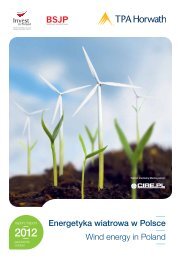Energetyka wiatrowa w Polsce Wind energy in Poland - TPA Horwath
Energetyka wiatrowa w Polsce Wind energy in Poland - TPA Horwath
Energetyka wiatrowa w Polsce Wind energy in Poland - TPA Horwath
Create successful ePaper yourself
Turn your PDF publications into a flip-book with our unique Google optimized e-Paper software.
jest ich podwyższona awaryjność oraz relatywnie<br />
niska moc znamionowa, pozorną zaletą zaś niska cena<br />
w porównaniu z nowymi siłowniami. Jeszcze dwa-trzy<br />
lata temu ok. 80% wniosków o przyłączenie do sieci<br />
dotyczyło właśnie przestarzałych elektrowni wiatrowych<br />
o małej mocy 23 . Wiele z nich f<strong>in</strong>ansowane było leas<strong>in</strong>giem.<br />
Jak podaje BZ WBK F<strong>in</strong>anse & Leas<strong>in</strong>g w latach<br />
2009-2010 aż 90% 24 sf<strong>in</strong>ansowanych <strong>in</strong>westycji wiatrowych<br />
dotyczyło używanych turb<strong>in</strong>.<br />
W państwach wysoko rozw<strong>in</strong>iętych podaż takich jednostek<br />
jest rezultatem tzw. repower<strong>in</strong>gu, który polega na<br />
zastępowaniu starych, słabszych turb<strong>in</strong> nowymi zespołami,<br />
często kilkukrotnie większej mocy. Częściowo<br />
wyeksploatowane elementy sprzedawane są do krajów,<br />
gdzie energetyka <strong>wiatrowa</strong> jest jeszcze w początkowym<br />
stadium rozwoju, m.<strong>in</strong>. do Polski. Problemy z tym<br />
związane są różnorakiej natury – w pierwszym rzędzie<br />
dochodzi do nieefektywnego, pod względem sprawności<br />
wytwarzania energii, wykorzystania lokalizacji<br />
dostępnych pod budowę farm wiatrowych. Jako że<br />
lokalizacje o dobrych lub bardzo dobrych parametrach<br />
wietrznych i <strong>in</strong>frastrukturalnych stanowią dobro coraz<br />
trudniej dostępne, kwestia ta z czasem nabiera coraz<br />
większego znaczenia. Drugi mankament to ryzyko<br />
techniczno-użytkowe związane z podwyższonym<br />
zagrożeniem wystąpienia awarii czy katastrofy budowlanej.<br />
Trzeci problem to rygorystyczne wymogi ochrony<br />
środowiska, zwłaszcza w zakresie emisji hałasu i pola<br />
elektromagnetycznego, których starsze urządzenia<br />
w dużym stopniu nie spełniają, niemniej zważywszy<br />
na ich rozmiar często unikają one większej części<br />
procedury planistycznej oraz kompleksowej oceny<br />
oddziaływania na środowisko, standardowej dla dużych<br />
i nowoczesnych <strong>in</strong>stalacji.<br />
Dynamiczny rozwój rynku energii wiatrowej w <strong>Polsce</strong>,<br />
w tym obecność coraz większej liczby <strong>in</strong>westorów<br />
zagranicznych, spowodował zmniejszenie opisywanego<br />
tu zjawiska. Używane turb<strong>in</strong>y wiatrowe przestają<br />
być wykorzystywane zwłaszcza w przypadku<br />
większych projektów. Jak podaje BZ WBK F<strong>in</strong>anse<br />
& Leas<strong>in</strong>g, w 2011 r. f<strong>in</strong>ansowane przez nią były już<br />
wyłącznie nowe turb<strong>in</strong>y o wysokiej mocy. Nie tylko<br />
rynek ale również legislacja idzie w kierunku promowania<br />
nowoczesnych rozwiązań technologicznych.<br />
Aktualny projekt ustawy o OZE zakłada, iż w przypadku<br />
modernizacji <strong>in</strong>stalacji powodującej przyrost<br />
mocy, świadectwa pochodzenia będą przysługiwać<br />
wyłącznie w sytuacji, gdy za<strong>in</strong>stalowane urządzenie<br />
zostało wyprodukowane nie później niż 36 miesięcy<br />
przed dniem rozpoczęcia modernizacji. Analogiczne<br />
rozwiązania będą dotyczyć wszystkich <strong>in</strong>stalacji oddanych<br />
do użytku od 2015 roku.<br />
23 PSEW: coraz więcej wniosków o przyłączenie elektrowni<br />
z demobilu” PAP, http://f<strong>in</strong>anse.wp.pl<br />
24 „Słabe prawo blokuje <strong>in</strong>westycje w wiatraki”,<br />
http://www.forbes.pl/artykuly/sekcje/wydarzenia/<br />
slabe-prawo-blokuje-<strong>in</strong>westycje-w-wiatraki,23346,1<br />
such used w<strong>in</strong>d turb<strong>in</strong>es is a higher failure rate, and<br />
their relatively low rated power, with the advantage of<br />
second-hand equipment be<strong>in</strong>g their attractive price<br />
as compared to new turb<strong>in</strong>es. Just 2 or 3 years ago,<br />
about 80% of grid connection applications referred<br />
to such outdated low-capacity w<strong>in</strong>d farms 23 . Many of<br />
those were f<strong>in</strong>anced with leas<strong>in</strong>g. Accord<strong>in</strong>g to BZ<br />
WBK F<strong>in</strong>anse & Leas<strong>in</strong>g, <strong>in</strong> 2009-2010 as much as<br />
90% 24 of f<strong>in</strong>anc<strong>in</strong>g referred to <strong>in</strong>vestments <strong>in</strong> used<br />
turb<strong>in</strong>es.<br />
In highly developed countries, the supply of such<br />
units is a consequence of the so-called repower<strong>in</strong>g,<br />
which consists <strong>in</strong> replac<strong>in</strong>g old low capacity turb<strong>in</strong>es<br />
with new sets whose capacity is often several times<br />
higher. Partially worn out components are sold to<br />
countries where w<strong>in</strong>d <strong>energy</strong> is still at the early stage<br />
of development, e.g. to <strong>Poland</strong>. Problems caused by<br />
that are multifaceted – first of all, locations available<br />
for w<strong>in</strong>d farm development are used <strong>in</strong>effectively<br />
from the po<strong>in</strong>t of view of <strong>energy</strong> generation efficiency.<br />
S<strong>in</strong>ce locations characterized by good or very good<br />
w<strong>in</strong>d potential and <strong>in</strong>frastructure parameters become<br />
<strong>in</strong>creas<strong>in</strong>gly hard to come by, the importance of that<br />
aspect becomes more and more prom<strong>in</strong>ent. Another<br />
disadvantage is the technical and functional risk<br />
related to the higher potential for failure or construction<br />
disaster. And the third key problem is posed by<br />
the strict environmental protection requirements,<br />
particularly with regard to noise and electromagnetic<br />
field emission, which are largely not met by older<br />
facilities; however, because of their size, such facilities<br />
are often able to avoid a major portion of the plann<strong>in</strong>g<br />
procedure and a comprehensive Environmental<br />
Impact Assessment – a standard requirement for<br />
larger and modern <strong>in</strong>stallations.<br />
As a result of the dynamic development of w<strong>in</strong>d <strong>energy</strong><br />
market <strong>in</strong> <strong>Poland</strong>, and especially an <strong>in</strong>crease <strong>in</strong> the<br />
number of foreign <strong>in</strong>vestors, the above-mentioned<br />
occurrence became less common. Larger-scale<br />
projects <strong>in</strong> particular no longer use second-hand<br />
turb<strong>in</strong>es. Accord<strong>in</strong>g to the data of BZ WBK F<strong>in</strong>anse<br />
& Leas<strong>in</strong>g, it only f<strong>in</strong>anced new, high-capacity<br />
turb<strong>in</strong>es <strong>in</strong> 2011. Promotion of modern technological<br />
solutions is at the focus of not only the market but<br />
also the legislation. The latest draft of the RES Act<br />
stipulates that if capacity of an <strong>in</strong>stallation <strong>in</strong>creases<br />
as a result of modernization, certificates of orig<strong>in</strong> will<br />
only be granted provided that the <strong>in</strong>stalled facility is<br />
manufactured not later than 36 months prior to the<br />
modernization commencement date. Analogous<br />
solutions will apply to all <strong>in</strong>stallations released for<br />
bus<strong>in</strong>ess use from 2015 onward.<br />
23 „PSEW: coraz więcej wniosków o przyłączenie elektrowni<br />
z demobilu” [PWEA: The Number of Applications for Connection<br />
of Used <strong>W<strong>in</strong>d</strong> Farms Grows]; PAP, http://f<strong>in</strong>anse.wp.pl<br />
24 „Słabe prawo blokuje <strong>in</strong>westycje w wiatraki” [Weak Law Blocks<br />
Investments <strong>in</strong> <strong>W<strong>in</strong>d</strong> Farms] http://www.forbes.pl/artykuly/sekcje/<br />
wydarzenia/slabe-prawo-blokuje-<strong>in</strong>westycje-w-wiatraki,23346,1<br />
<strong>Energetyka</strong> <strong>wiatrowa</strong> w <strong>Polsce</strong> / <strong>W<strong>in</strong>d</strong> <strong>energy</strong> <strong>in</strong> <strong>Poland</strong><br />
51



